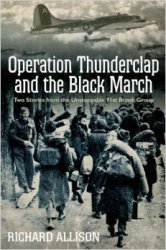Operation Goodwood, the powerful thrust past the east of Caen by British and Canadian divisions on July 18, called for the use of large numbers of medium and heavy bombers to blast a path through enemy defenses. In the heaviest and most concentrated air attack yet made in support of a ground action, nearly 2,000 bombers were to lay carpets of bombs across designated target areas ahead of the advancing troops. RAF Bomber Command opened the attack at dawn, when Pathfinder Mosquitoes marked the five target areas which were then bombed by 1,013 Lancasters and Halifaxes. Later that morning, 571 B-24 Liberators of the US 8th Air force attacked five more target areas. Then 318 medium bombers of the US 9th Air Force — A-20 Havocs, B-25 Mitchells and B-26 Marauders - attacked a further five target areas. During these attacks seven heavy bombers were lost, all of them to flak.
The bombs fell across positions manned by the 21st Panzer Division and the 16th Luftwaffe Field Division and caused considerable losses and disruption to their defenses. One company of 21st Panzer, laagered in farm buildings around the village of Guillerville, was hit particularly hard. It had 15 of its tanks put out of action and the area was cratered to such an extent that its surviving vehicles were unable to move. During the hours immediately following the bombing the attacking troops advanced rapidly, but then the defenders recovered and were able to halt their progress.
On July 25/26 in a similar series of attacks in a prelude to Operation Cobra, large forces of Flying Fortresses and Liberators of the US 8th Air Force put down a carpet of bombs along the Periers-St. L6 highway and some 1,200 yards (1,000m) in front of troops of the US First Army who were preparing to attack. On this occasion the targets were too close to US forward positions for safety, however, and several sticks of bombs fell across US Army positions causing more than 600 casualties and leaving some units in a dazed condition. As a result the subsequent land attack achieved little. The lesson was clear: when heavy bombers were used to support the land battle, a separation of at least 3,000 yards (2,700m) from the nearest Allied positions was necessary if such losses were to be avoided.




 World History
World History









